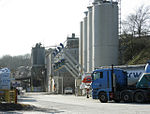Ashwick Court
Country houses in SomersetGrade II* listed buildings in Mendip DistrictGrade II* listed houses in SomersetUse British English from June 2012

Ashwick Court is Grade II* listed house on Heckley Lane northwest of Ashwick, in Mendip district, eastern Somerset, England, adjacent to the Church of St James. It is a country house, dating from the late 17th century and became a listed building on 2 June 1961. Alterations were added to the property in the 18th and mid-19th century.
Excerpt from the Wikipedia article Ashwick Court (License: CC BY-SA 3.0, Authors, Images).Ashwick Court
Heckley Hill, Mendip
Geographical coordinates (GPS) Address Nearby Places Show on map
Geographical coordinates (GPS)
| Latitude | Longitude |
|---|---|
| N 51.2345 ° | E -2.5217 ° |
Address
St James Church
Heckley Hill
BA3 5BG Mendip
England, United Kingdom
Open on Google Maps








